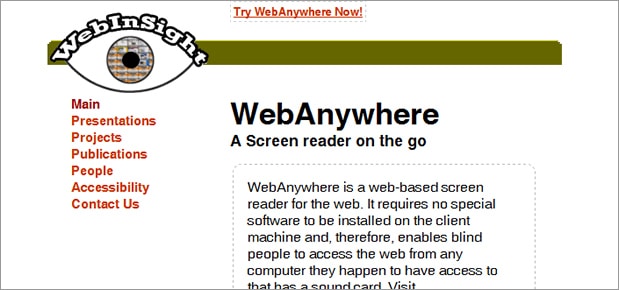

Dolphin is probably the closest in relation to JAWS, with the exception that it does not have its own scripting language to make as versatile as JAWS. Much like JAWS, Dolphin is highly customizable, supports multiple languages, multiple braille displays, and has OCR (optical character recognition) built in. DOLPHIN SCREEN READERĭolphin Screen Reader is comparable in feature set to JAWS, at a very close matching price point.
#Screen reader software windows
While a deep knowledge of the inner workings of JAWS isn’t required to use its more basic functions (such as using the Internet, checking email, and utilizing Windows basic functions), for a user that is only interested in basic functionality may be better served at a better price point with some of the other screen readers discussed further down.
#Screen reader software software
It wouldn’t be uncommon to require tens of hours of tutorials across all its different functions to really get a new user up and running and comfortable with using the software - and even more so if they wanted to dive into programming using its scripting language. As well, because of the feature rich nature of JAWS, the learning curve can be fairly unforgiving, with many people needing a certain level of training to ensure that they are getting the most out of the software. With a hefty price tag, some people may find the cost of JAWS and the premium screen readers like it a bit prohibitive. While JAWS may currently dominate the market share of screen readers, its powerful features means that it is among the highest priced Screen Readers on the market. Perhaps the most powerful aspect of JAWS however comes in the form of its proprietary scripting language, that can be used to further customize the software and give it to make other aspects of Windows or Windows based software accessible.īut being such a powerful piece of software comes with a price, literally. It also includes a distinct mode for Browser software, making it an extremely versatile way to access web content. JAWS has the ability to attach shortcut keys or key combos to almost every Windows function. The biggest strength of JAWS is the fact that has been around longer than any other screen reader and, as a result, features the longest list of powerful features and comprehensive customization options.

Recent surveys have placed it at the top of the screen reader pile, with over 46% of the surveyed claiming to use it as their primary screen reader, and 66% saying that they use it often. JAWS was first developed for computers using the DOS operating system in 1989 and since then has supported almost every version of Windows. This particular JAWS stands for Job Access With Speech, is made by Freedom Scientific, and has been the premiere screen reader for over 20 years. And no, we’re not talking about that big fake looking shark from Spielberg’s magnum opus. JAWSĪny discussion of screen readers will usually begin with JAWS.

There are many different options these days, and most of the time your choice will come down to what you need out of your screen reader and how much you can spend on it. So with that taken care of, let’s dive down and look at the various options when it comes to choosing what screen reader will work for you. Screen reading software also acts as an intermediary between a device and another piece of Assistive Technology such as a Braille Display. Screen readers essentially allow for the visually impaired to operate digital devices as well (if not better) than their sighted counterparts. A screen reader is simply a piece of software that runs alongside an operating system that uses text-to-speech technology to voice what would normally be displayed on the screen. So let’s start with a fairly simple definition of just what a screen reader is. So we thought - ‘what are we going to order into the office for lunch?’ And then - once we figured that out - we thought, ‘what better topic for a blog post?’ Quite often at Canadian Assistive Technology we are approached by people unfamiliar with screen readers who are unsure where to start in terms of research and really don’t have any idea of what screen reader would be right for them. And once that day comes and they’re faced with diving head first into the screen reader market, they often find it can be quite intimidating at first. Screen reading software has been around for many years as a solution for the visually impaired to access computers and digital devices, but they often remain essentially unknown among people until the day they need them.


 0 kommentar(er)
0 kommentar(er)
